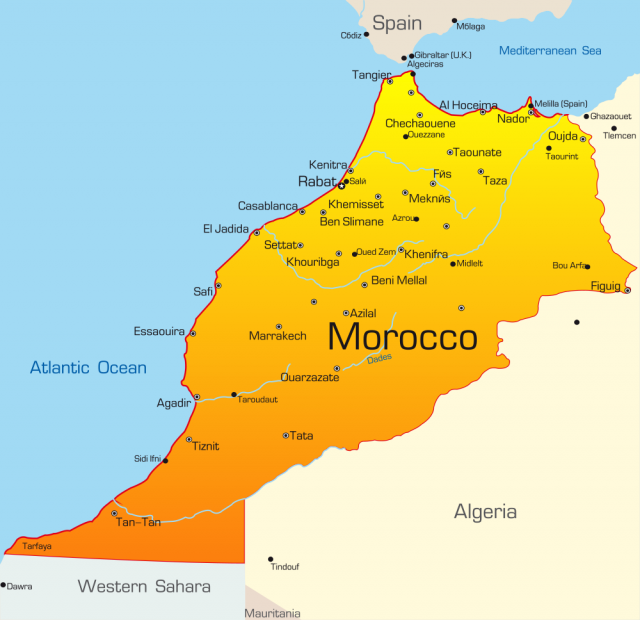Morocco
Area 172,413 square mi (446,550 square km)
Population 33.92 million (2014)
Capital Rabat
Highest Point 13,665 ft (4,165 m)
Lowest Point -180 ft (-55 m)
GDP $107.0 billion (2014)
Primary Natural Resources agriculture, phosphate mining, minerals.
MOROCCO REPRESENTS the finest example of multicultural fusion, combining 2,000 years of languages, rituals and customs, cuisine and foods, and religions into one colorful and productive blend called Al Maghreb. Once hosting vital Roman outposts at the pastoral Volubilus and coastal Lixus, Morocco has seen North African, European, and Asian allies, marauders, and colonizers come and go. However, it has always emerged enriched, and maybe that is why Morocco has developed a culturally embedded sense of acceptance along with its native Berber roots of hospitality.

Located on the western edge of North Africa and situated on both the MEDITERRANEAN SEA and ATLANTIC OCEAN, Morocco shares borders with the countries of ALGERIA and WESTERN SAHARA. Slightly larger than the state of CALIFORNIA, Morocco's long coastlines and mountainous spines afford it varied climatic regimes and agricultural production. The country is dominated by a number of ranges, including the Rif, Middle, High and Anti-ATLAS MOUNTAINS. Towering above the plains of Marrakech lies Mount or Jebel Toubkal with its often cloud-hidden peak of some 13,000 ft (3,000 m) above sea level.
Morocco's change in relief from sea level to its high peaks produces a wide assortment of fruits, nuts, vegetables, and livestock—adding to Morocco's famous cuisine. Integrated Berber, Arab, French, and Spanish residents have all helped create a culture like no other. Crisp and succulent baked pigeon pies, stews of lamb and prunes, and chicken with raisins have elevated Moroccan cuisine to among the most favored and sought in the world.
From the calm blue Mediterranean Sea to the rough, grey Atlantic Ocean, Morocco's coastal plains support thriving farms and orchards, urban and industrial centers, and its primary highways and roads. And although the Atlas Mountains separate the coastal plains from the broad SAHARA DESERT and prevent easy access to either side, these impressive plains, peaks, coasts, and valleys have helped create the unique character of Morocco.
The Kingdom of Morocco was a French protectorate from 1912 to 1956, when Sultan Mohamed became the king. From the house of Alawi and a direct descendant of Muhammad, the Prophet of Islam, the sultan was succeeded in 1961 by his son Hassan, who ruled for 38 years. King (or Malak) Hassan, a popular ruler and clever statesman, played a major role in the Palestine-Israel peace process, since many of the earliest immigrants to Israel came from Morocco. In 1976, Hassan inspired thousands of Moroccans, with greenbound Qur'ans in hand, to march into the nation of WESTERN SAHARA to the south, demanding annexation to Morocco. This “Green March” fomented the occupation of Western Sahara, whose status and boundaries are still unresolved.
While the whole of Morocco mourned the death of their leader King Hassan in 1999, his son ascended to the throne to become King Mohammed VI. Following his father's death, King Mohammed declared his support of the constitutional monarchy, a successful political plurality, a moderate economy, and a new thrust to alleviate poverty and unemployment throughout the kingdom. He has proved himself to be opposed to Islamic radicals and has supported private media and the freedom of speech. However, in 2003, the French organization Reporters sans Frontieres condemned Morocco for its “regular interference” in media censorship by the kingdom's intelligence services. Increasingly, self-censorship within media organizations is widespread.